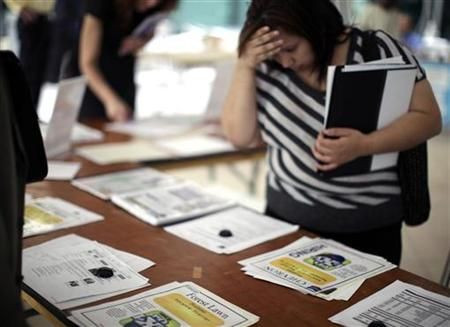US Unemployment Rate Likely To Hold At 8.2% In April

Hiring in the U.S. likely picked up somewhat in April after a disappointing showing in March renewed fears of another spring slump in the labor market, economists said in anticipation of the April non-farm payroll report due Friday.
Payrolls are estimated to have climbed last month by 170,000, after a smaller-than-expected 120,000 gain in March, according to the median forecast of 73 economists surveyed by Reuters. The projections ranged from 105,000 to 210,000.
April and March together, I would expect them to be weaker than January and February, said David Levy, chairman of Jerome Levy Forecasting Center.
Many indicators released ahead of Friday's jobs report, however, revealed troubling signs in the labor market, which led some economists to conclude that April's results will once again fall shy of expectations.
I would not be surprised to see Friday's employment numbers come in on the low side of that range, said Lance Roberts, chief strategist at StreetTalk Advisors.
Economists also expect Friday's report to show April's unemployment rate holding at a three-year low of 8.2 percent as the labor participation rate continues to slip.
In March, the labor participation rate, which is the amount of working-age people who have jobs or are still looking for jobs, fell slightly to 63.8 percent from 63.9 percent in the prior month. When the recession officially started in December 2007, the labor participation rate stood at 66 percent and the unemployment rate was at 5 percent.
The pace of job creation is central to President Barack Obama's re-election chances in November, when the economy is likely to be the top issue for voters.
In January 2009, when Obama entered office, the unemployment rate was 7.8 percent. The jobless rate peaked at 10 percent nine months later. Since August, it has tumbled from 9.1 percent to 8.2 percent.
If the job numbers start to get weaker, that's going to throw fuel into the Romney camp, Roberts said. Historically speaking, no president has ever been elected to a second term when unemployment has been above 8 percent.
Currently, the U.S. still has about 13 million people who are unemployed, against 142 million employed people, and 88 million who are out of the labor force, data from the Bureau of Labor Statistics showed.
Weather Payback
We expect a payback in the spring that starts out small in March but grows in April, Merrill Lynch analyst Neil Dutta wrote in an April 23 note to clients. The likelihood is that activity, particularly across many retail establishments, was pulled forward into the winter at the expense of the spring.
The U.S. has enjoyed an exceptionally mild winter, with fewer layoffs occurring in weather-sensitive sectors, which resulted in bigger seasonally-adjusted employment gains.
The January to March period was the warmest first quarter in records going back to 1895, according to the National Oceanic and Atmospheric Administration.
Goldman Sachs chief economist Jan Hatzius pointed out that there was not much payback in March, as the payroll growth pace in the cold and warm states was in line with the pre-winter pace, suggesting that the payback for the elevated growth rates in prior months has yet to occur.
We believe that the partial normalization of the weather, and more importantly, the fact that weather doesn't matter as much for the level of payrolls after March, will lead to a payback of at least 50,000 in the April report, Hatzius wrote in an April 27 note to clients.
The job market has obviously slowed from the start of the year and the number of people seeking unemployment benefits has increased in the past month, suggesting that companies have laid off more workers.
The four-week moving average on initial jobless claims, which smooths out weekly volatility, is running at its highest level since January.
A separate report showed U.S. private sector added far fewer jobs than forecast in April.
The New Jersey-based ADP Employer Services reported an increase of 119,000 jobs in April, compared to an expectation of 177,000 jobs created. Construction employment fell by 5,000, the first decline in seven months and following healthy gains during the unusually warm winter months.
As a preliminary gauge of private payrolls, ADP has a mixed track record compared to the official Labor Department numbers. ADP's initial figures for March showed a gain of 209,000, while the Labor Department said companies added 121,000 workers. Nonetheless, Wednesday's figures reflected a deceleration in the recent pace of hiring.
Private Payrolls, Manufacturing
Private employment likely rose 175,000, after a 121,000 gain in March, according to the survey. Manufacturing is expected to have added 22,000 jobs in the month, down from 37,000 in the prior month. However, Wednesday's ADP report revealed manufacturing employment dropped by 5,000 jobs, the first loss since September of last year.
The importance of U.S. manufacturing cannot be overstated. If U.S. manufacturing were a country by itself, it would rank as the ninth largest economy in the world, according to the Manufacturing Institute.
Manufacturing has remained the bright spot in this recovery all along and now economists are worried that the sector could be peaking out.
The U.S. manufacturing has begun a secular recovery, Levy said. It's going to be a much stronger part of the global production in the long run, but we are still going to get hit by the cycle.
Tuesday's ISM manufacturing index, which measures manufacturing activities on a national level, came in well ahead of market expectations, rising to 54.8 in April from 53.4 in March, the highest since June 2011. That provided a welcome relief from a string of soft regional manufacturing measures. Notably, a gauge of the Chicago-area manufacturing activities slowed in April to the weakest growth rate in 29 months.
The regional manufacturing index is more sensitive to what's really going on in the economy and it tends to lead the ISM by about a month, Roberts said. So very likely, the weakness that we have seen over the last couple of months in the regional manufacturing indexes will show up in ISM in the next month.
More importantly, a slowdown in key markets such as Europe and China has been hurting U.S. exports.
Clearly, our economy is being more affected by the softening in the world economy than in the past because our exports, and this is a good thing, have actually been growing relatively to the size of our economy, Levy said.
But that means we are more affected by the world and the world economy almost everywhere has been slowing down, if not contracting in a few places, Levy added.
Echoing that view, Roberts said he would expect to see manufacturing being the first area to get hit because of export-related weakness, as a lot of the regional surveys are showing that employers are not hiring.
Recessionary Levels
The long, tepid post-recession recovery has lowered American's expectations to a great extent.
Historically, in every past recession, people are freaking out about being in a recession when initial jobless claims are at 320,000 or 340, 000, Roberts said. We are happy at 380,000. If you look at most of the indices, we are still hovering at very recessionary levels, however, consumer confidence is up.
Consumer confidence improved significantly over the past month with both the Conference Board and University of Michigan consumer sentiment surveys rising to their highest level in a year.
The Commerce Department said Friday the U.S. economy expanded at 2.2 percent annual rate in the first quarter after a 3 percent increase in the prior three months.
We've injected $29 trillion in various forms of bailouts from Bear Stearns to Maiden Lane buying toxic assets, to bailing out AIG, to quantitative easing one, two, operational twist, so forth and so on, Roberts said. Three years into a post-recessionary environment, we should be growing at between 6 and 8 percent with no liquidity injection.
It really shows you how fragile we are, without the financial support from the government, the picture would look drastically different, Roberts added.
This helps explain why Federal Reserve policy makers are sticking to a plan that holds borrowing costs at rock-bottom levels through late 2014 to spur growth.
Speaking at a news conference on following the April Federal Open Market Committee meeting, Fed Chairman Ben Bernanke said the central bank remains ready to act.
We remain entirely prepared to take additional balance sheet actions if necessary to achieve our objectives, Bernanke told reporters. So those tools remain very much on the table, and we would not hesitate to use them should the economy require that additional support.
Unsustainable Household Purchases
Bigger gains in hiring and wages are needed to sustain household purchases, which accounts for more than 70 percent of U.S. economic growth. In the first quarter of 2012, consumer spending climbed 2.9 percent, the fastest pace since the end of 2010.
However, that rate might not be sustainable.
How much Americans are bringing home and where they are getting their income from tells two very different stories.
Personal income was up $50.3 billion, or 0.4 percent, in March. Yet, nearly a quarter of that income came from some type of transfer.
Personal current transfer receipts increased $11.6 billion in March, compared with an increase of $300 million in February. Within current transfer receipts, government social benefits to persons for social security increased $6.8 billion, compared with an increase of $2.6 billion.
There's a tremendous amount of external support to income at this point other than wages and salaries, which are not growing at a rate to offset the increases in inflationary pressures, according to Roberts.
Food and energy are now eating up more than 20 percent of wages and salaries and you've got 46 million people on food stamps, Roberts said.
Meanwhile, the personal savings rate has dropped to 3.8 percent, which doesn't leave much room for consumers to take more money out.
Very likely, we are going to see a decrease in consumption in the next couple of quarters as consumers cannot carry the full burden of the economy at 71 percent of consumption for much longer, Roberts said.
FOMC
At their most recent meeting in April, members of the FOMC said they expect growth to remain moderate over coming quarters and then to pick up gradually, while noting that inflation has picked up somewhat.
In describing the job market, Fed officials said the unemployment rate has declined but remains elevated, while in March, they said the jobless rate had declined notably in recent months but remains elevated.
Fed officials reduced their forecast for unemployment after payroll gains averaged more than 200,000 a month during the first quarter, while affirming a plan to keep the benchmark lending rate around zero, at least through late 2014.
Policy makers forecast the unemployment rate would average 7.8 percent to 8 percent in the final three months of this year, compared with a forecast of 8.2 percent to 8.5 percent in January. However, the new forecasts are still far above officials' estimates for full employment, which range from 4.9 percent to 6 percent.
Nothing is going to greatly change the Fed's position, Levy said, referring to Fed's possible reactions to the results of the upcoming non-farm payrolls report. Basically nothing is going to happen unless until people get scared enough.
Market Reaction
Markets often react strongly to Friday's employment report.
If Friday's report come in at 210,000, people will get all excited, especially if they revise up last month's figure, Levy said. If we drop below 100,000, even if last month's figure is revised up, that will really scare people.
It has become a theater of the moment and just one more data point in a big mix of confusing sense of what's going on.
© Copyright IBTimes 2024. All rights reserved.






















